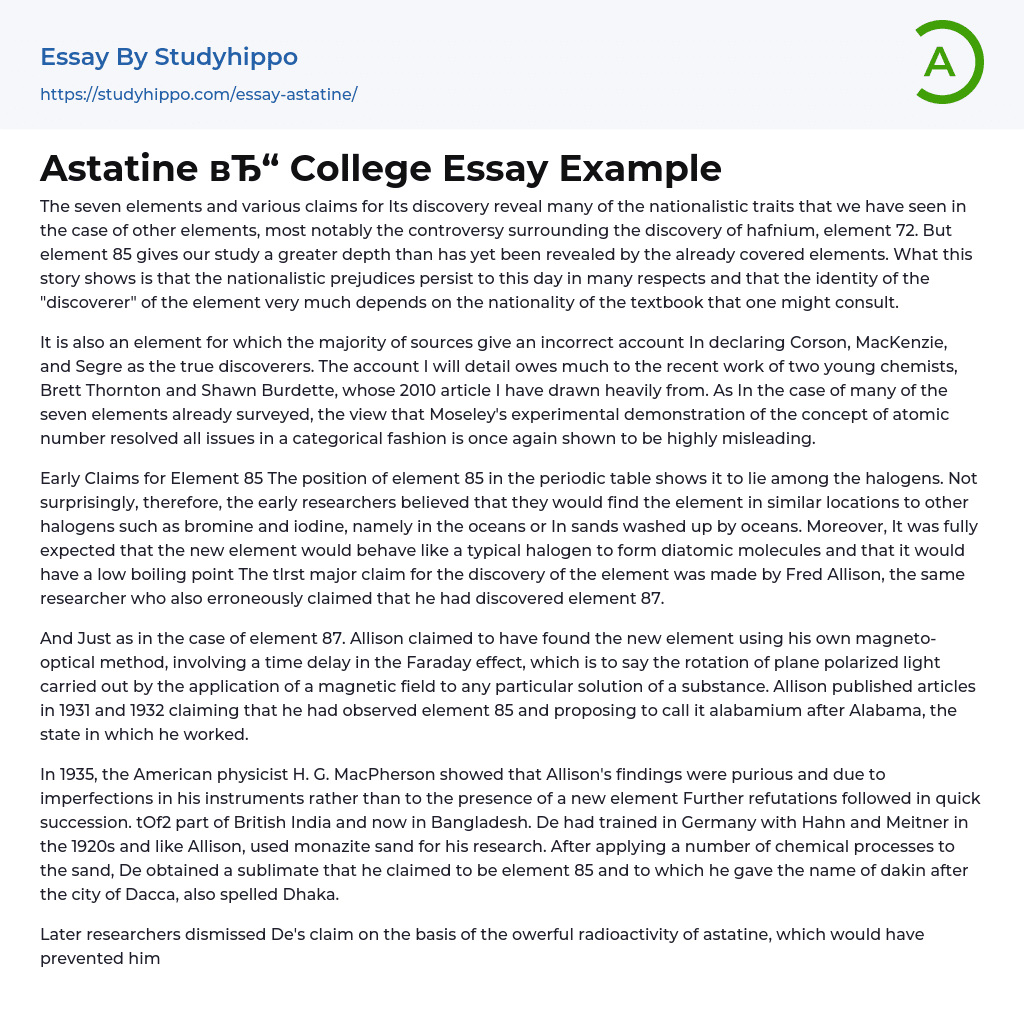The seven elements and various claims for Its discovery reveal many of the nationalistic traits that we have seen in the case of other elements, most notably the controversy surrounding the discovery of hafnium, element 72. But element 85 gives our study a greater depth than has yet been revealed by the already covered elements. What this story shows is that the nationalistic prejudices persist to this day in many respects and that the identity of the "discoverer" of the element very much depends on the nationality of the textbook that one might consult.
It is also an element for which the majority of sources give an incorrect account In declaring Corson, MacKenzie, and Segre as the true discoverers. The account I will detail owes much to the recent work of two young chemists, Brett Thornton and Shawn
...Burdette, whose 2010 article I have drawn heavily from. As In the case of many of the seven elements already surveyed, the view that Moseley's experimental demonstration of the concept of atomic number resolved all issues in a categorical fashion is once again shown to be highly misleading.
Early Claims for Element 85 The position of element 85 in the periodic table shows it to lie among the halogens. Not surprisingly, therefore, the early researchers believed that they would find the element in similar locations to other halogens such as bromine and iodine, namely in the oceans or In sands washed up by oceans. Moreover, It was fully expected that the new element would behave like a typical halogen to form diatomic molecules and that it would have a low boiling point The tlrst major claim for the discover
of the element was made by Fred Allison, the same researcher who also erroneously claimed that he had discovered element 87.
And Just as in the case of element 87. Allison claimed to have found the new element using his own magneto-optical method, involving a time delay in the Faraday effect, which is to say the rotation of plane polarized light carried out by the application of a magnetic field to any particular solution of a substance. Allison published articles in 1931 and 1932 claiming that he had observed element 85 and proposing to call it alabamium after Alabama, the state in which he worked.
In 1935, the American physicist H. G. MacPherson showed that Allison's findings were purious and due to imperfections in his instruments rather than to the presence of a new element Further refutations followed in quick succession. tOf2 part of British India and now in Bangladesh. De had trained in Germany with Hahn and Meitner in the 1920s and like Allison, used monazite sand for his research. After applying a number of chemical processes to the sand, De obtained a sublimate that he claimed to be element 85 and to which he gave the name of dakin after the city of Dacca, also spelled Dhaka.
Later researchers dismissed De's claim on the basis of the owerful radioactivity of astatine, which would have prevented him or anybody else from safely handling the element in the manner he claimed to have done at the time. Another person who had been involved in the search for element 87, Romanian Horia Hulubei, was also involved in the discovery of element 85. Indeed it appears that he may well have
been the discoverer of naturally occurring astatine, as it was later called by the physicists who synthesized the element artificially. It is these physicists who are generally accorded with the discovery of the element.
- Organic Chemistry essays
- Acid essays
- Calcium essays
- Chemical Bond essays
- Chemical Reaction essays
- Chromatography essays
- Ethanol essays
- Hydrogen essays
- Periodic Table essays
- Titration essays
- Chemical reactions essays
- Osmosis essays
- Carbohydrate essays
- Carbon essays
- Ph essays
- Diffusion essays
- Copper essays
- Salt essays
- Concentration essays
- Sodium essays
- Distillation essays
- Amylase essays
- Magnesium essays
- Acid Rain essays
- Professor essays
- Should College be Free essays
- Should college athletes be paid essays
- College Education essays
- College Tuition essays
- Graduation essays
- College Goals essays
- Personal Statement essays
- Online Classes Vs Traditional Classes essays
- Online Education essays
- Student Loan essays
- Study Abroad Scholarship essays
- Reasons To Go To College essays
- Paying College Athletes essays
- Technology In The Classroom essays
- Energy essays
- Density essays
- Thermodynamics essays
- Motion essays
- Atom essays
- Sound essays
- Electricity essays
- Nuclear Power essays
- Temperature essays
- Physiology essays
- Light essays




